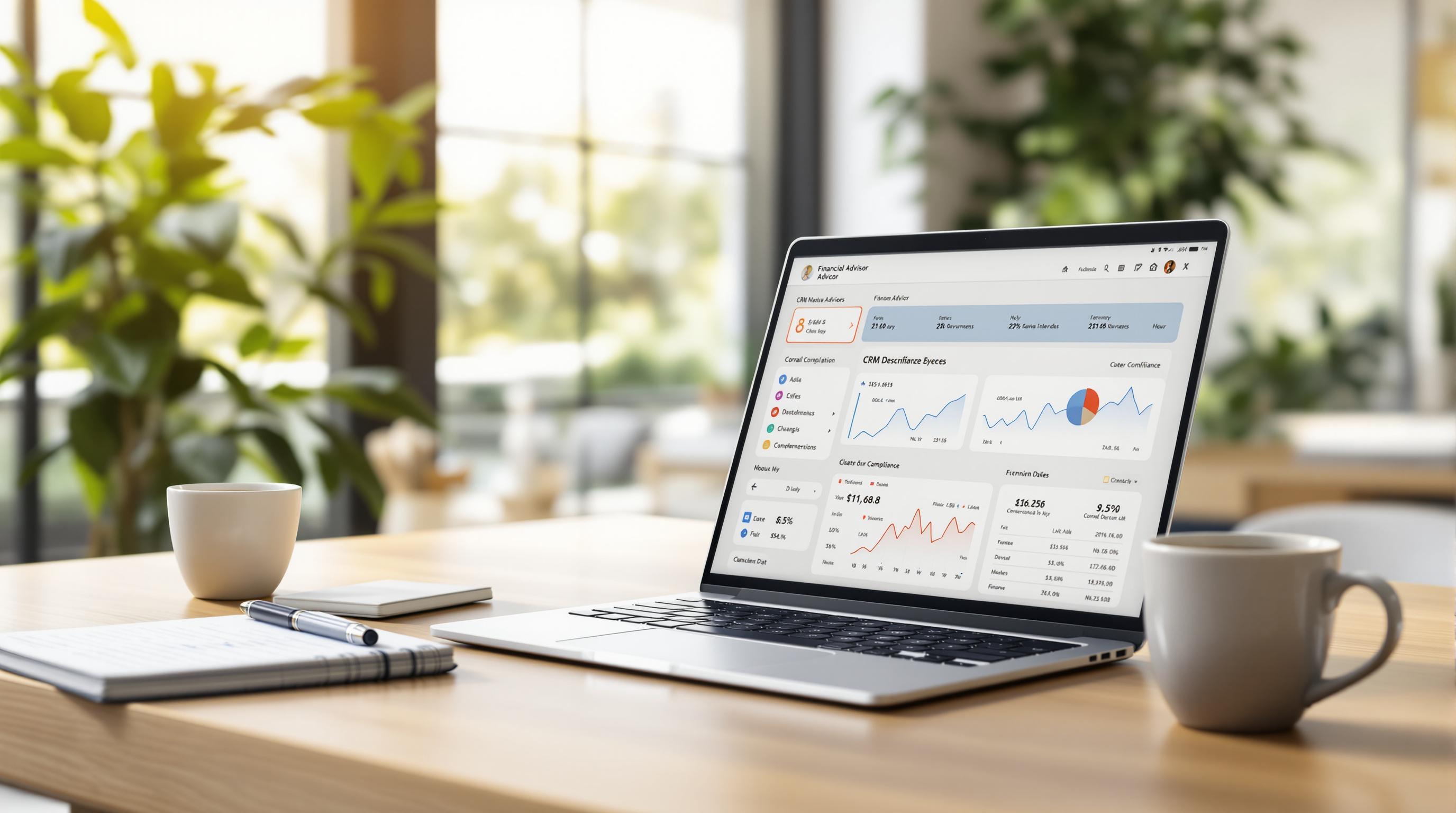Want to improve your email marketing as a financial advisor? Personalization is the key. Tailored emails can boost open rates by up to 29%, increase click-through rates by 10.64%, and help build trust with clients. This guide covers 8 practical tips to personalize your emails effectively:
- Segment Your Email List: Group clients by demographics, financial goals, or life stages for targeted messaging.
- Use Dynamic Content: Tailor email sections based on recipient data, like portfolio size or past interactions.
- Write Better Subject Lines: Add personal touches (e.g., names) to increase open rates by up to 57%.
- Match Content to Client Needs: Address specific financial priorities like retirement planning or wealth building.
- Send Action-Based Emails: Trigger emails based on client actions, like webinar sign-ups or resource downloads.
- Use Your Name as the Sender: Build trust by sending emails from a real, recognizable name.
- Make Data-Based Suggestions: Use portfolio analytics to offer personalized financial advice.
- Create Specific Action Buttons: Design clear, goal-oriented CTAs like "Review Your Portfolio" or "Plan Your Retirement."
These strategies ensure your emails resonate with clients and drive engagement. Ready to strengthen your client relationships? Let’s dive in.
1. Split Your Email Lists by Client Type
Organizing your email subscribers into distinct groups is a smart way to make your communication more relevant and engaging. By tailoring your messages to specific types of clients, you can strengthen relationships and boost interaction.
How to Segment Your Email List
Here are some useful criteria for dividing your audience:
- Demographics: Think age or location.
- Financial Goals: Consider their portfolio size or investment objectives.
- Life Stage: Are they building wealth, nearing retirement, or already retired?
- Email Behavior: Look at how often they open or click on your emails.
Automating Your Segments
Leverage tools that automatically adjust your segments based on client actions or financial updates. Just make sure to stay compliant - always get consent and provide easy opt-out options.
| Client Segment | Content Focus | Email Frequency |
|---|---|---|
| Young Professionals | Tips on building wealth, long-term investing | Every two weeks |
| Pre-retirees | Retirement planning, protecting assets | Once a month |
| High-net-worth | Estate planning, tax strategies | Monthly + Market Updates |
| New Clients | Onboarding guides, educational content | Weekly (first month only) |
Keep It Fresh
Review your segmentation every quarter to ensure it stays accurate. Use your email platform's analytics to check engagement metrics like open rates and clicks. This will help you adjust your strategy and keep your content on point.
"Regular updates help in maintaining the accuracy of the segmentation and ensuring that the content remains targeted and engaging" [2].
Once your list is well-organized, focus on crafting messages that resonate with each group. Tailored content is key to making an impact.
2. Add Content That Changes Per Recipient
Dynamic content lets you tailor emails to each recipient by using data like their goals, portfolio size, or past interactions. For instance, if you're discussing retirement planning, a pre-retiree might get tips on maximizing Social Security benefits, while a younger professional might receive advice on building long-term investment strategies.
Impact and Examples
Personalized emails in the financial world deliver strong results: dynamic content can increase click-through rates by 76%, boost conversions by 45%, and grow revenue by 96% [1]. A great example is Credit Karma, which sends credit alert emails customized with details like account changes, credit score updates, and tailored financial advice.
Making It Work
Use your email platform's dynamic content tools to create personalized blocks, add specific data, and set up conditional logic for targeted messaging. This approach shows clients you understand their financial needs, helping to build trust and loyalty.
"In a world of crowded inboxes, personalization is your key to standing out against the competition." - Tracie Pang, Email Marketing Manager at Litmus [1]
After personalizing your email content, spend time crafting subject lines that grab attention and encourage recipients to open and engage.
3. Write Better Subject Lines
Almost half of email recipients decide to open messages based on the subject line alone. Adding a personal touch, like a name or specific details, can boost open rates by 57%. For financial advisors, crafting subject lines that directly address a client’s situation - using their name or focusing on their financial interests - can make a big difference.
Here are some examples that work well:
- "[First Name]'s Q1 Investment Performance Review"
- "Market Updates for [Company Name] 401(k) Participants"
- "[First Name], 3 Tax-Saving Strategies for Your Portfolio"
Key Elements for Success
Aim for subject lines between 30-50 characters to ensure they display properly on all devices. Focus on delivering value rather than sounding overly promotional.
"When it comes to email marketing, the best subject lines tell what's inside, and the worst subject lines sell what's inside." - MailChimp
Testing for Better Results
Before sending emails to your full list, test your subject lines on smaller groups. This helps identify what resonates most with your audience.
Here are some test examples:
- "Your Q1 Portfolio Review" vs. "John, Here's Your Q1 Portfolio Performance" (testing personalization)
- "3 Retirement Planning Tips" vs. "Retirement Planning: New Strategies for 2025" (testing numbered vs. descriptive styles)
- "Market Update: Your Next Steps" vs. "Important: Market Changes Affecting Your Investments" (testing urgency vs. informative tone)
Personalized subject lines that include names or financial details can lead to open rates improving by as much as 188% compared to generic ones [1].
Once you’ve nailed your subject lines, make sure the email content delivers exactly what your clients are looking for.
4. Match Content to Client Needs
Crafting email content that directly addresses your clients' financial goals and situations is key to keeping them engaged. In fact, using data to personalize content can boost engagement by up to 73% compared to generic messaging [1].
Understanding Client Segments
Every client has unique financial priorities. Here's a quick guide to help you tailor your content for different groups:
| Client Segment | Primary Concerns | Content Focus |
|---|---|---|
| Young Professionals (25-35) | Debt Management, Investment Basics | Budgeting tips, 401(k) optimization |
| Mid-Career (35-50) | College Planning, Portfolio Growth | Education savings, investment strategies |
| Pre-Retirees (50-65) | Retirement Planning, Estate Planning | Social Security timing, wealth transfer |
| Business Owners | Tax Strategies, Succession Planning | Business valuation, exit strategies |
Fine-Tuning Content
Keep an eye on metrics like open rates, click-through rates, and time spent reading to see what resonates with each group. Dynamic content tools can help you adjust your messages - for example, focusing on long-term investment advice for younger clients or withdrawal strategies for those nearing retirement.
"When financial advisors use data to inform their content decisions, they see engagement rates improve by up to 73% compared to generic messaging approaches." [1]
Timing Matters
Timing can make or break your email strategy. Share tax strategies during tax season, year-end portfolio tips in December, or milestone-specific advice for birthdays. By sending relevant content at the right moment, you’ll keep your emails both useful and timely.
To take it a step further, consider syncing your emails with client actions for even better results.
5. Send Emails Based on Client Actions
Behavioral email campaigns let you connect with clients in a more personal way by sending messages triggered by their actions. These emails can lead to incredible results, with trigger-based emails showing 497% higher response rates compared to standard batch emails [1].
Key Trigger Points
Certain client actions, like signing up for a webinar or downloading a resource, provide perfect opportunities to send targeted, timely emails. Here are a few examples:
| Client Action | Trigger Email Content | Timing |
|---|---|---|
| Webinar Registration | Follow-up with resources or slides | Within 24 hours |
| Resource Download | Share related financial tips | 2-3 days after |
| Portfolio Review | Send updates on investment strategies | Within 48 hours |
Setting Up Action-Based Automation
Most email marketing tools allow you to automate responses based on client behavior. For instance, if someone browses retirement planning content on your site, you can automatically send them resources on Social Security or estate planning.
These automated workflows are incredibly effective - triggered emails account for over 75% of email revenue [2]. Just make sure your messages stay relevant and don’t overwhelm your audience with too many automated emails.
Measuring Success
To gauge how well your campaigns are performing, focus on:
- Open and click-through rates: Segmented, targeted emails often see a 23% boost in opens and a 49% increase in clicks.
- Engagement speed: Check how quickly clients interact with your triggered emails.
Timing is everything. For example, if someone downloads a retirement guide, send them follow-up resources within 48 hours to keep their interest alive.
sbb-itb-e3190ce
6. Use Your Name as the Sender
Trust starts with making your emails feel personal and direct. Instead of using generic addresses like "info@" or "newsletter@", sending emails from your actual name can make a big difference in how clients view and engage with your messages.
Why It Matters
Using your name and a professional email address (like john.smith@advisoryfirm.com) helps create a personal connection. Pair this with a professional email signature that includes your name, credentials, contact details, and even a headshot to boost credibility and professionalism.
How to Set It Up
Make sure your email platform is configured to always show your name as the sender. This is especially important if multiple team members are part of your email campaigns. Most email marketing tools let you easily customize sender information - take advantage of this feature to ensure consistency across all your emails.
This simple change works well with techniques like segmentation and dynamic content, making your emails feel more personal and relevant. Research shows that personalized sender names, when paired with other personalization strategies, can lead to better engagement rates [1].
Once your emails feel personal and direct, you can take it further by using client data to offer tailored recommendations that truly connect.
7. Make Data-Based Suggestions
Using client data effectively can transform ordinary emails into tailored financial advice. Adding personalized, data-driven insights into your email strategy helps build trust and keeps clients engaged.
Using Portfolio Analytics
Zero in on key financial metrics to create meaningful suggestions. For example, if a client’s portfolio leans heavily toward a specific sector, your email can recommend adjustments to align with their goals.
Types of Data-Driven Recommendations
| Recommendation Type | Data Source | Example Suggestion |
|---|---|---|
| Investment Rebalancing | Client Portfolio Data | "Your technology sector exposure is now 45%. Consider rebalancing to reach your 30% target." |
| Tax Planning | Transaction History | "Recent stock sales might provide opportunities for tax-loss harvesting." |
| Retirement Planning | Age and Portfolio Size | "Increasing your monthly savings by 3% could help address potential shortfalls." |
Implementation Strategy
Link your CRM with your email platform to automate personalized suggestions. This ensures your advice stays timely and relevant to your clients’ needs.
Best Practices
- Respect client privacy.
- Keep advice focused and relevant.
- Time messages around key financial milestones.
After providing tailored recommendations, encourage clients to take action with clear, well-placed call-to-action buttons.
8. Create Specific Action Buttons
Personalized CTAs (Call-to-Actions) can turn email engagement into meaningful client interactions. Instead of generic buttons like "Learn More", craft CTAs that directly address your clients' financial goals and unique circumstances.
Design Tips for CTA Buttons
CTA buttons should stand out visually while maintaining a professional look. Use contrasting colors that align with your brand and ensure buttons are mobile-friendly (a size of at least 44x44 pixels is ideal). Considering that over 60% of emails are opened on mobile devices, responsive design is a must to keep performance consistent across platforms.
Here are examples of tailored CTAs for various client groups:
| Client Segment | Example CTA | Purpose |
|---|---|---|
| Pre-Retirees | "Calculate Your Retirement Readiness" | Encourages engagement with retirement tools |
| Business Owners | "Review Your Business Succession Plan" | Focuses on specific business planning needs |
| High Net Worth | "Access Your Wealth Management Dashboard" | Offers instant portfolio oversight |
| New Investors | "Start Your Investment Strategy Session" | Provides a gateway to financial guidance |
Measuring CTA Effectiveness
To improve your CTAs, track these metrics:
- Click-through rates for different button placements
- Conversion rates based on CTA type
- Engagement patterns across mobile and desktop users
Make sure your primary CTA is placed above the fold for maximum visibility and impact. By refining your CTAs, you can drive better client interactions and underscore the importance of personalized communication.
Conclusion
Personalized email strategies can greatly improve client relationships and deliver measurable outcomes. For example, data shows they can boost open rates by up to 29% [4].
The secret to success? Focus on techniques that match your clients' needs and align with your business goals. Here's a simple framework to get started:
| Phase | Focus Area | Timeline |
|---|---|---|
| Foundation | Begin with list segmentation and tailored subject lines | 1-2 months |
| Development | Add dynamic content and behavioral triggers | 2-3 months |
| Advanced | Use data insights and custom CTAs | 3-4 months |
Personalization works best when you combine data-driven insights with a relatable, human approach to build trust and professionalism [1]. If you're a financial advisor looking to streamline your email efforts, Financial Advisor Marketing offers a list of 51 tools to improve client communication while staying compliant.
Keep an eye on metrics like open rates, click-throughs, and conversions to fine-tune your campaigns [2]. As you gain confidence, you can gradually adopt more advanced methods to strengthen client connections [3].
FAQs
What is the best way to run a segmented e-mail campaign?
Running a segmented email campaign effectively means tailoring your approach to different groups within your audience. Here's a simple framework to guide you:
- Welcome new subscribers with a series of emails introducing your services and sharing helpful resources.
- Engage active clients by sending updates on portfolios or sharing relevant market insights.
- Reward high-value clients with exclusive offers or invitations to VIP events.
- Reconnect with inactive clients using special promotions or updates about your services.
| Segment Type | Purpose | Example Content |
|---|---|---|
| New Subscribers | Onboarding | Welcome emails, educational resources |
| Active Clients | Relationship Building | Portfolio updates, market insights |
| High-Value Clients | Premium Service | Exclusive offers, VIP event invitations |
| Inactive Clients | Re-engagement | Service updates, special promotions |
To get the best results, set clear goals for each segment and use behavioral triggers to send personalized content. Keep an eye on metrics like open and engagement rates, and tweak your approach based on what works.
With 72% of clients preferring email [2], segmentation is a smart way to ensure your campaigns are relevant and impactful.


